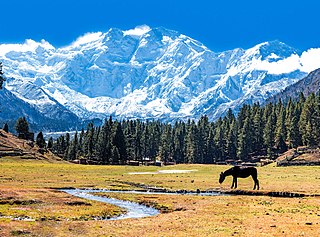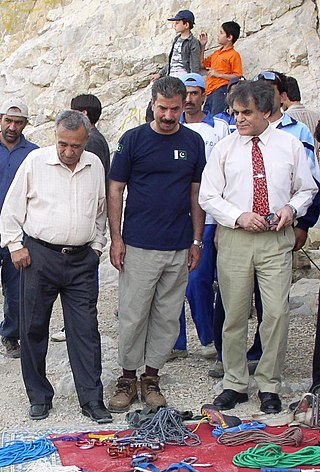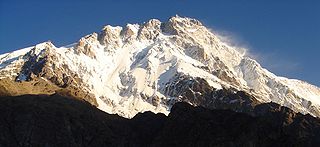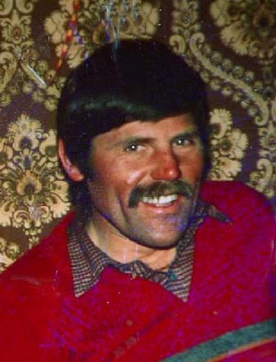
The third man factor or third man syndrome refers to the reported situations where an unseen presence, such as a spirit, provides comfort or support during traumatic experiences.

The third man factor or third man syndrome refers to the reported situations where an unseen presence, such as a spirit, provides comfort or support during traumatic experiences.
Sir Ernest Shackleton, in his 1919 book South , described his belief that an incorporeal companion joined him and his men during the final leg of his 1914–1917 Antarctic expedition, which became stranded in pack ice for more than two years and endured immense hardships in the attempt to reach safety. Shackleton wrote, "during that long and racking march of thirty-six hours over the unnamed mountains and glaciers of South Georgia, it seemed to me often that we were four, not three." [1] His admission resulted in other survivors of extreme hardship coming forward and sharing similar experiences.
Who is the third who walks always beside you?
When I count, there are only you and I together
But when I look ahead up the white road
There is always another one walking beside you
Gliding wrapt in a brown mantle, hooded
I do not know whether a man or a woman
— But who is that on the other side of you?
Lines 359 through 365 of T. S. Eliot's 1922 modernist poem The Waste Land were inspired by Shackleton's experience, as stated by the author in the notes included with the work. It is the reference to "the third" in this poem that has given this phenomenon its name (when it could occur to even a single person in danger).
In recent years, well-known adventurers like climber Reinhold Messner and polar explorers Peter Hillary and Ann Bancroft have reported experiencing the phenomenon. One study of cases involving adventurers reported that the largest group involved climbers, with solo sailors and shipwreck survivors being the second most common group, followed by polar explorers. [2] A similar experience was documented by mountain climber Joe Simpson in his 1988 book Touching the Void , which recounts his near-death experience in the Peruvian Andes. Simpson describes "a voice" which encouraged him and directed him as he crawled back to base camp after suffering a horrible leg injury high on Siula Grande and falling off a cliff and into a crevasse. Some journalists have related this to the concept of a guardian angel or imaginary friend. Scientific explanations consider the phenomenon a coping mechanism or an example of bicameral mentality. [3] The concept was popularized by a 2009 book by John G. Geiger, The Third Man Factor, which documents scores of examples.
Modern psychologists have used the "third man factor" to treat victims of trauma. The "cultivated inner character" lends imagined support and comfort. [4]
In Geraldine McCaughrean's 2005 young adult fiction novel The White Darkness , the teenage heroine, Sym, joins a doomed Antarctic expedition. Abandoned and lost, she is guided to safety by a "third man", her imaginary friend, Captain Lawrence Oates.
In Larry McMurtry's 1985 Western novel Lonesome Dove , Pea Eye, after surviving an Indian attack with Gus, makes a trek back to Call and has an experience of a "ghost" or "spirit" that guides him during his walk.
Thomas Pynchon's 2006 novel Against the Day makes reference to the experience.
In Max Brooks's 2006 novel World War Z , Colonel Christina Eliopolis crash lands in the midst of zombie-infested territory but is able to survive and be picked up with the assistance of a Sky Watcher codenamed "Mets Fan", who is later revealed to be a figment of her imagination. She maintains the belief that Mets is a real person.
In the 2006 film The Guardian , a drowning sailor, being rescued by Ashton Kutcher's character Jake, asks, "Where is he?" and then tells of a man who had stayed with him and held him up until help arrived.
In the 2013 film Gravity , biomedical engineer Ryan Stone watches astronaut Matt Kowalski float away into space to certain death. Later in the film, as an exhausted Stone is about to give up, we see Kowalski appear and enter her space capsule, supposedly having survived. He gives Stone the strength of will to continue, and shows her a means to return to Earth, before being revealed as a figment of her imagination.
In the 1984 film Cloak & Dagger, Davey Osborne, a child who uses his imagination to replace his absentee father, is pursued by criminals attempting to retrieve hidden data from one of Davey's video game cartridges. In moments of danger and high stress, a Special Forces agent named Jack Flack seemingly magically appears to guide Davey through the situations. Notably, the characters of Jack Flack and Davey's father are both portrayed by the same person, actor Dabney Coleman.
In the 2023 book Into the Uncanny, author Danny Robins puts forward the idea that the Third Man Factor could potentially account for some reported ghost sightings, especially those in which the witness is being put under intense stress or mental strain.
In Season 25, episode 8 of Law and Order: SVU , the episode is titled "Third Man Syndrome" and the phenomenon is addressed, explained and brought to the attention of Captain Benson by a detective in her squad when she mentions the victim seeing someone who wasn't there.
In the Bible, Daniel 3:23-26, the story of Shadrach, Meschach and Abednego recounts a situation where three men were thrown into a fiery furnace, but witnesses say there was a fourth figure with them that looked like an angel.

Mount Everest is Earth's highest mountain above sea level, located in the Mahalangur Himal sub-range of the Himalayas. The China–Nepal border runs across its summit point. Its elevation of 8,848.86 m was most recently established in 2020 by the Chinese and Nepali authorities.
The Seven Summits are the highest mountains on each of the seven traditional continents. On 30 April 1985, Richard Bass became the first climber to reach the summit of all seven.

Lhotse is the fourth-highest mountain on Earth, after Mount Everest, K2, and Kangchenjunga. At an elevation of 8,516 metres (27,940 ft) above sea level, the main summit is on the border between Tibet Autonomous Region of China and the Khumbu region of Nepal.

Reinhold Andreas Messner is an Italian climber, explorer, and author from South Tyrol. He made the first solo ascent of Mount Everest and, along with Peter Habeler, the first ascent of Everest without supplemental oxygen. He was the first person to climb all 14 eight-thousanders, doing so without supplementary oxygen. Messner was the first to cross Antarctica and Greenland with neither snowmobiles nor dog sleds and also crossed the Gobi Desert alone. He is widely considered to be the greatest mountaineer of all time.

Cho Oyu is the sixth-highest mountain in the world at 8,188 metres (26,864 ft) above sea level. Cho Oyu means "Turquoise Goddess" in Tibetan. The mountain is the westernmost major peak of the Khumbu sub-section of the Mahalangur Himalaya 20 km west of Mount Everest. The mountain stands on the China Tibet–Nepal Koshi Pradesh border.

Nanga Parbat, known locally as Diamer, is the ninth-highest mountain on Earth and its summit is at 8,126 m (26,660 ft) above sea level. Lying immediately southeast of the northernmost bend of the Indus River in the Gilgit-Baltistan region of Pakistan-administered Kashmir, Nanga Parbat is the westernmost major peak of the Himalayas, and thus in the traditional view of the Himalayas as bounded by the Indus and Yarlung Tsangpo/Brahmaputra rivers, it is the western anchor of the entire mountain range.

Broad Peak is one of the eight-thousanders, and is located in the Karakoram range spanning Gilgit-Baltistan, Pakistan and Xinjiang, China. It is the 12th highest mountain in the world with 8,051 metres (26,414 ft) elevation above sea level. The first ascent of this mountain was in June 1957, accomplished by Fritz Wintersteller, Marcus Schmuck, Kurt Diemberger, and Hermann Buhl as part of an Austrian expedition.

Krzysztof Jerzy Wielicki is a Polish mountaineer, regarded as one of the greatest Polish climbers in history. He is the 5th man to climb all fourteen eight-thousanders and the first ever to climb Mount Everest, Kangchenjunga, and Lhotse in winter. He is a member of The Explorers Club.

Nazir Sabir is a Pakistani mountaineer. He was born in Hunza. He has climbed Mount Everest and four of the five 8000 m peaks in Pakistan, including the world's second highest mountain K2 in 1981, Gasherbrum II 8035m, Broad Peak 8050m in 1982, and Gasherbrum I 8068m in 1992. He became the first from Pakistan to have climbed Everest on 17 May 2000 as a team member on the Mountain Madness Everest Expedition led by Christine Boskoff from the United States that also included famed Everest climber Peter Habeler of Austria and eight Canadians.

Arved Fuchs is a German polar explorer and writer.

Elizabeth Hawley was an American journalist, author, and chronicler of Himalayan mountaineering expeditions. Hawley's The Himalayan Database became the unofficial record for climbs in the Nepalese Himalaya. She was also the honorary consul in Nepal for New Zealand.
Stephanie Jutta Schwabe is a geomicrobiologist. She completed a Ph.D. in the biogeochemical investigation of caves within the Bahamian carbonate platforms, commonly referred to as blue holes. She is an expert geologic diver mostly in Bahamian blues holes, though her experience extends to expeditions in U.S. waters. Diver International named her one of the top 40 divers in the world.
Russell Reginald Brice is a New Zealand mountaineer. He was the owner/manager of Himex, a climbing expedition company. He has summited Cho Oyu seven times, Himal Chuli and Mount Everest twice, as well as Manaslu in October 2010, which was his 14th summit of an 8000 m peak.
Andrew James Lock OAM is an Australian mountaineer. He became the first, and still remains the only, Australian to climb all 14 "eight-thousanders" on 2 October 2009, and is the 18th person to ever complete this feat. He climbed 13 of the 14 without bottled oxygen, only using it on Mount Everest, which he has summited three times. He retired from eight-thousander climbing in 2012.
John Grigsby Geiger is an American-born Canadian author. He is best known for his book The Third Man Factor: Surviving the Impossible, which popularized the concept of the "third man", an incorporeal being that aids people under extreme duress. The book is the basis for a National Geographic Channel video entitled Explorer: The Angel Effect, in which Geiger appears. In turn, a second book on the topic, based on, and taking its name from the National Geographic video, was published in 2013. His other works include the international bestseller Frozen in Time: The Fate of the Franklin Expedition. In 2013, Geiger was appointed Chief Executive Officer of the Royal Canadian Geographical Society.

Eric Jones is a Welsh solo climber, skydiver and BASE jumper.

Stipe Božić is a Croatian mountaineer, documentary filmmaker, photographer and writer. He is the most successful Croatian Himalayan climber. Božić completed the Seven Summits and is the second European, after Reinhold Messner, to climb the highest peak in the world, Mount Everest, twice. He has directed more than 60 documentary films, mostly related to mountains and climbing.

Günther Messner was an Italian mountaineer from South Tyrol and the younger brother of Reinhold Messner. Günther climbed some of the most difficult routes in the Alps during the 1960s, and joined the Nanga Parbat-Expedition in 1970 just before the beginning of the expedition due to an opening within the team.

Franz Oppurg was an Austrian mountain climber. Having climbed from a young age, he became a mountain guide and rescuer, and did a number of first ascents in the winter of mountains in his native Karwendel. He was also the first climber to achieve a solo ascent of Mount Everest.
Peter H. Hackett is an American mountaineer and medical doctor. He is the third person to have summited Mount Everest in a solo ascent, climbing from South Col to the top on October 24, 1981. He studies the effect of altitude on human physiology, and is the founder of a medical rescue camp on Everest and a rescue clinic and lab on Mount Denali, and the director of the Institute for Altitude Medicine in Colorado.